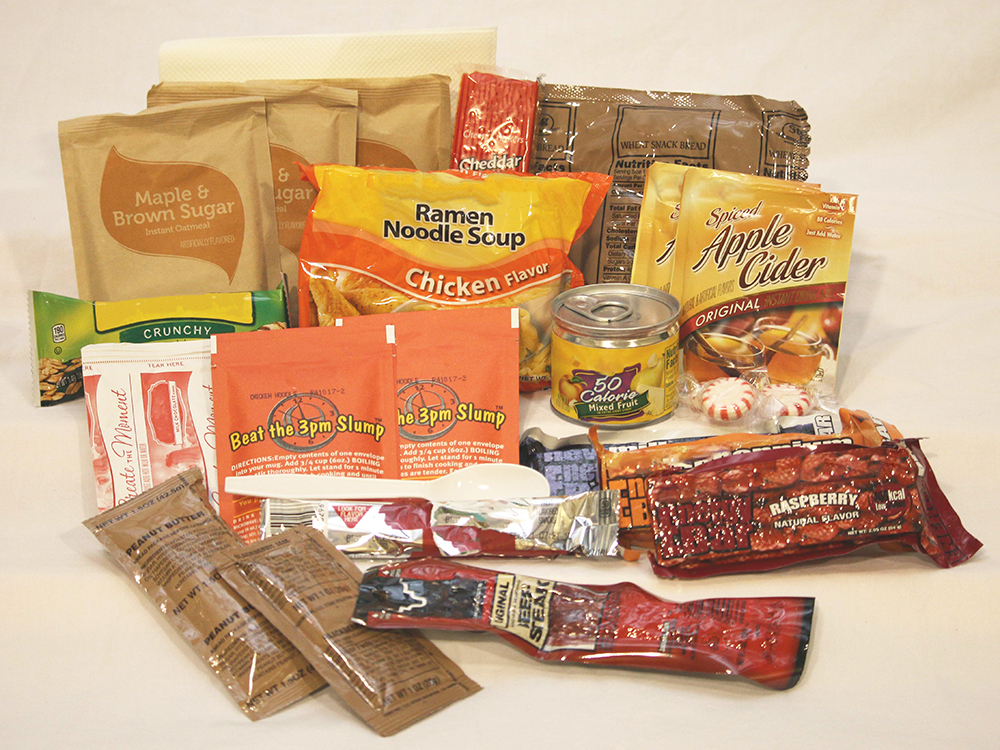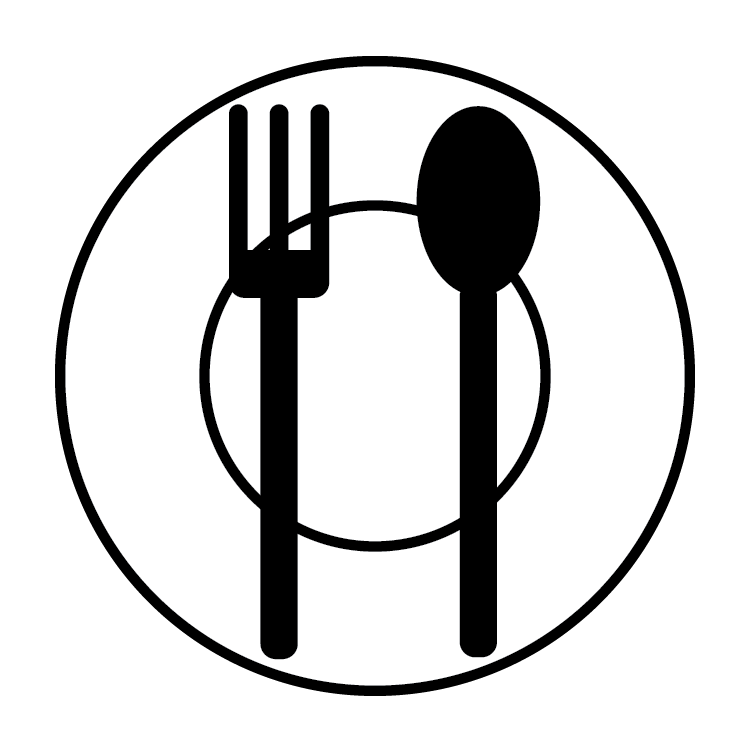
Food Storage and Nutrition
The Point
There are a lot of stories throughout history of people eating strange things because they were starving. Through war, famine, political and economic turmoil, natural and man made disaster, people have been known to eat tree bark, shoes, dirt, pets, and worse.
You can only last three to four weeks without adequate nutrition. Have a basic food storage supply for maintaining your energy and health in an emergency, and to keep yourself and your family from hunger and malnutrition. Gathering and storing food and other supplies now will help your family "be ready" for an emergency and have peace of mind in the event of a disaster.
Do This
- Determine the dietary needs of your family members. Are there allergies or other food restrictions?
- Make a list of the foods that your family eats for a month and create a one month menu of foods that can be made from your pantry and food stores. Make sure you are covering the basics of nutrition.
- Store a MINIMUM one month food supply in your home for you and your family. Work towards a three month supply.
- Create a food and emergency storage room or area in your home.
- Develop and maintain a food rotation system to prevent waste.
- Try new foods and recipes to add to the variety in your food storage. Keep the ones you and your family like and will eat.
- BONUS: Try growing sprouts for healthy greens anytime of the year. Incorporate them into your meals.
- BONUS: Start a garden and learn how to grow your own food.
- BONUS: Store enough food for your entire household for a year.
- BONUS: Learn how to preserve food to add to your food storage.
VIDEOS
- It's NOT Toxic! Canned Food Best By Dates
- Eggs Food Storage
- The Be Ready Buzz: Food in Disaster Supply Kits
- The Be Ready Buzz: Eat What You Store
- The Be Ready Buzz: Try New Food Storage Recipes
- The Be Ready Buzz: Store What You Eat
- PrepCast: Nutrition and Long-Term Food Storage
- PrepCast: Eat What You Store, Store What You Eat
- 20 to Ready: Emergency Food Storage
- 20 to Ready: Long Term Food Storage
DOWNLOADS
LINKS
- Disaster Supply Kit: Food
- USU Ext: Food Storage in the Home
- USU Ext: Food Storage
- USU Ext: Preserve the Harvest
- USU Ext: Avoid Food Waste and Save Money
- USU Ext: What to Do When the Freezer Goes Out
- USU Ext: Take Stock before Restocking Food Storage
- USU Ext: Make A Healthy Lifestyle
- USU Ext: Ingredient Substitutions for Cooking & Baking
- MyPlate.gov: MyPlate Food Groups
- USDA: Keeping Food Safe During an Emergency
- USDA: Food Product Dating
- CDC: Food Safety for Power Outages
- FoodSafety.gov: Food Safety in a Disaster or Emergency
You can only last up to three or four weeks without proper nutrition. Eat what you store to promote rotation and eliminate waste. Store what you eat so your body is used to the food and you know your household members will eat it. Plan your food storage around a balanced diet. Start with a three day supply in your disaster supply kit and work towards a goal of a MINIMUM one month supply for each member of the household. You will want to continue working toward a three month supply or more depending on your budget, abilities, and storage space. Store it in cool, dark, and dry conditions to maintain shelf life. Having a food storage supply is essential for maintaining your energy and health in an emergency situation. If you feel you have enough for your family to last for many months or longer, you may want to get some extra to share with your family, friends, and neighbors who may not be as prepared. Food has always been a good barter item in times of scarcity. Utah State University Extension's comprehensive Guide to Food Storage for Emergencies has many details to help you further understand how you can develop a safe and effective food storage plan for you and your family.
Nutrition
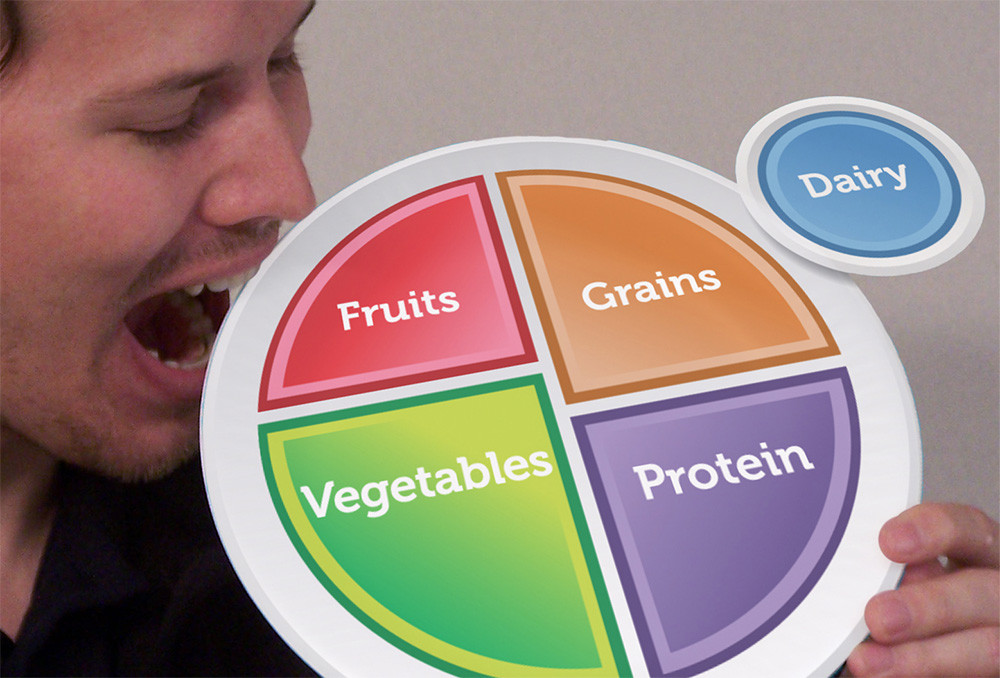 Food is composed of proteins, fats, vitamins, carbohydrates, minerals, amino acids, trace elements, fiber, etc., all of which are necessary for a healthy diet, healthy body, and a healthy lifestyle. It is vital to maintain your health in stressful situations like disasters when medical help may not be as available as it is normally. A healthy body helps to reduce injuries, disease, and illness, all of which are common in emergency situations.
Food is composed of proteins, fats, vitamins, carbohydrates, minerals, amino acids, trace elements, fiber, etc., all of which are necessary for a healthy diet, healthy body, and a healthy lifestyle. It is vital to maintain your health in stressful situations like disasters when medical help may not be as available as it is normally. A healthy body helps to reduce injuries, disease, and illness, all of which are common in emergency situations.
The MyPlate.gov program is a reliable source on food nutrition and is a good basis for creating a nutritional food storage plan for you and your family. It includes all the nutritional elements that we need to consider for our food storage.
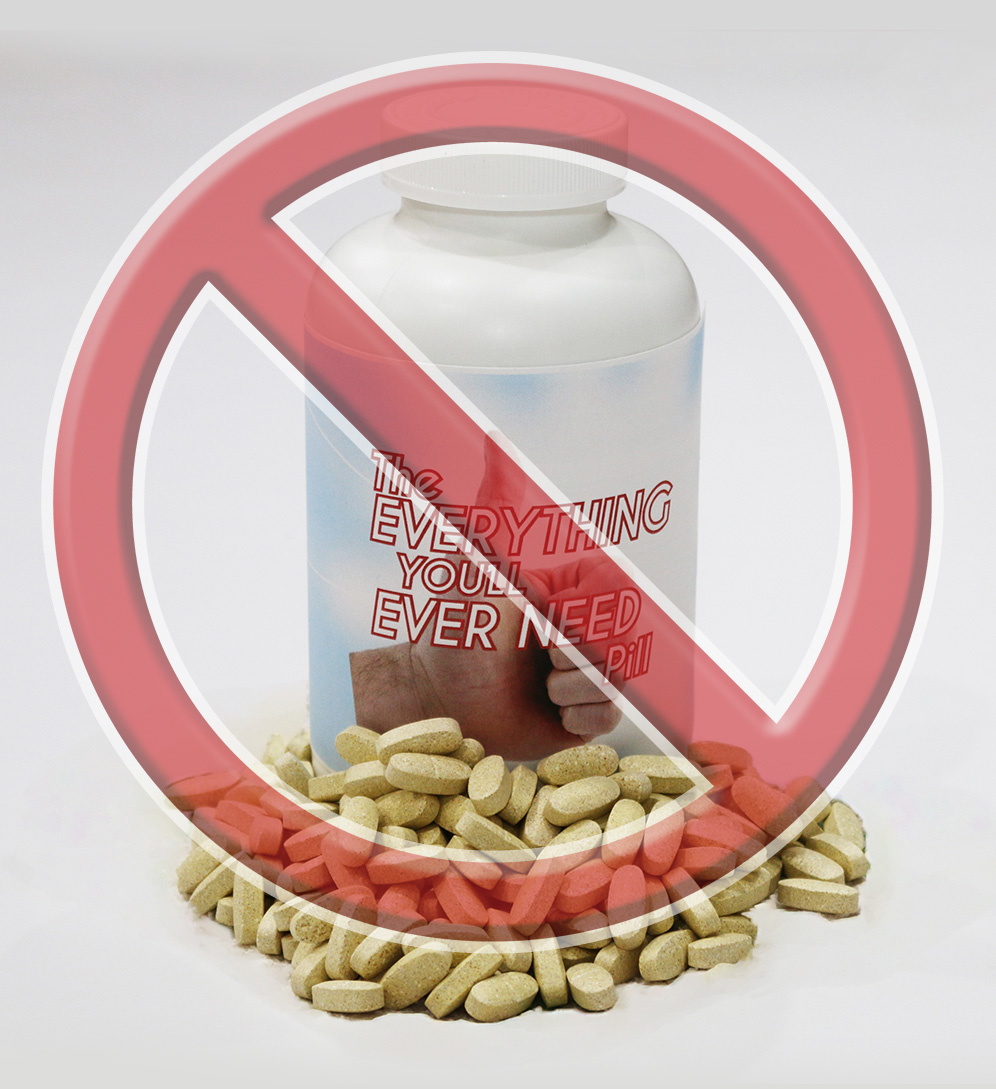
There is no perfect nutrition pill
Remember that variety is not only the spice of life, but that is where you get your nutrition. There is no perfect food or complete nutrition pill that covers everything your body needs. We can’t just store 1000 pounds of wheat in the basement and call our food storage done. We need to have different kinds of food to maintain our health. Variety fills in nutrition gaps between foods and relieves food monotony.
There are many different lists that say what you need in terms of food storage. You need to tailor make your own lists based on the recommendations provided here from Be Ready Utah, University of Utah Extension, and other food storage list suggestions you find on your own. Consider your needs, wants, abilities, resources, and budget when creating the lists for your family.
In addition to complete healthy and nutritional needs, be aware of the specific dietary needs and restrictions of your family members when putting together your food storage. Thinking that "they'll eat it if they get hungry enough" cannot apply to allergies, food intolerances, and other health issues. Imagine finding out you or a child have a severe allergic reaction to whole wheat, and that is the staple you based your food storage around. Don’t buy or store foods you are allergic to. You won’t be able to eat them, even if that is all that is left.
Elderly, infants, children, and nursing mothers may need milder and easier to digest foods than what is usually on the average food storage list.
Pets have a more difficult time than humans in changing their diets. Be sure to have plenty of pet food stock-piled as well. Learn what other foods your pets can and cannot eat.
Eat What You Store and Store What You Eat
 Eating from your food storage supplies promotes rotation and prohibits waste. Many people get discouraged about food storage because they figure it is only for emergency use and may turn out to be a waste of time and money. Supplies need to be constantly used, replaced, rotated, and cared for as your normal, everyday meals so they are not wasted. Doing this allows your digestive systems to become accustomed to the food for the time of need when fresher food is unavailable. You save money when you buy food in bulk, when it is on sale and in case lot sales. If you wait until you runout of an item or when you need it, it may not be available or it may be way more expensive— especially if it is during an emergency.
Eating from your food storage supplies promotes rotation and prohibits waste. Many people get discouraged about food storage because they figure it is only for emergency use and may turn out to be a waste of time and money. Supplies need to be constantly used, replaced, rotated, and cared for as your normal, everyday meals so they are not wasted. Doing this allows your digestive systems to become accustomed to the food for the time of need when fresher food is unavailable. You save money when you buy food in bulk, when it is on sale and in case lot sales. If you wait until you runout of an item or when you need it, it may not be available or it may be way more expensive— especially if it is during an emergency.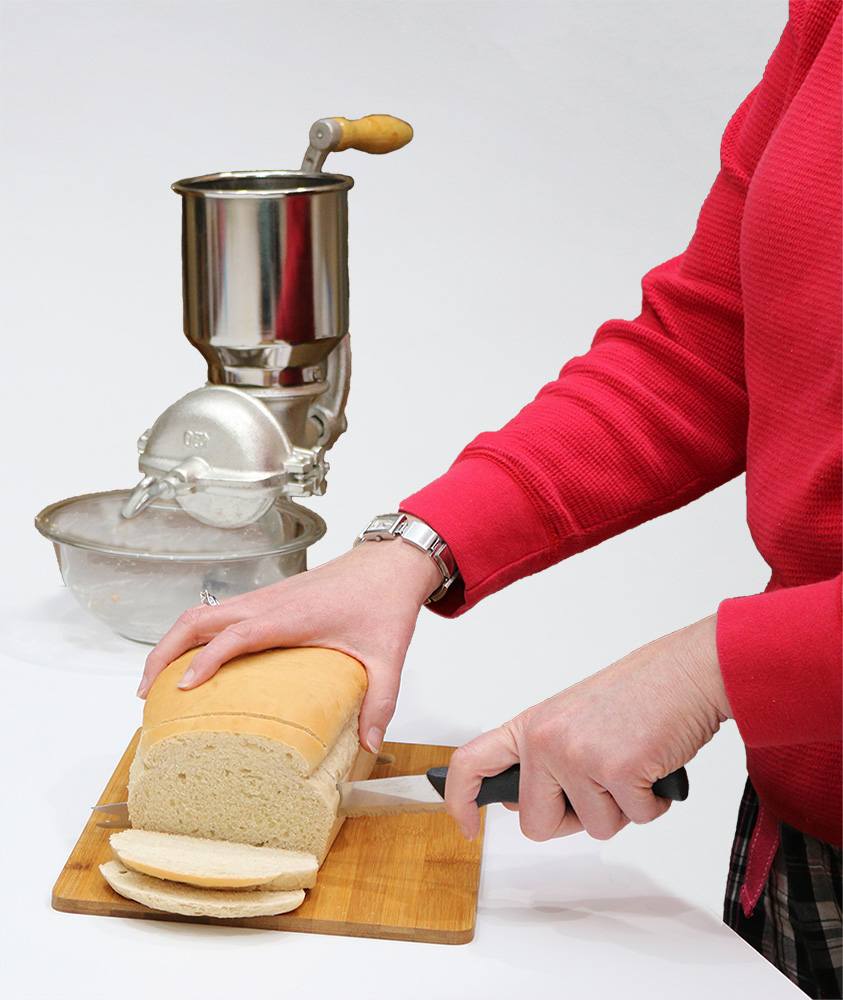
Learn how to use your food and other emergency storage supplies in a non-stressful situation. Do you have whole grains as part of your food storage? If so, figure out your grinder now. Are you planning on making your own bread? Learn how now. Are you planning on using your canning supplies for an emergency that is longer in duration? Learn how to can, bottle, and preserve now. There are many skills for food preparation, preservation, and cooking that you may not use on a day-to-day basis, but that would be valuable skills to have in an emergency situation. Learn them now when the trial and error learning process will not be as potentially costly.
Now is also a good time to try new recipes made from your food storage. Learn what foods and recipes you and your family like. You'll probably find some that you really like and may want to incorporate those into your normal family meals. As you try new things, you may want to expand the basic ingredients, seasonings, and spices that you have on-hand in your pantry and food storage. Make it a fun activity for everyone to experiment with new foods. Allow everyone to share their honest opinions. If you find some foods and recipes that you don't like, don't include them in your food supplies, take them out of your recipe box, or mark them as a "NO" in your recipe book.
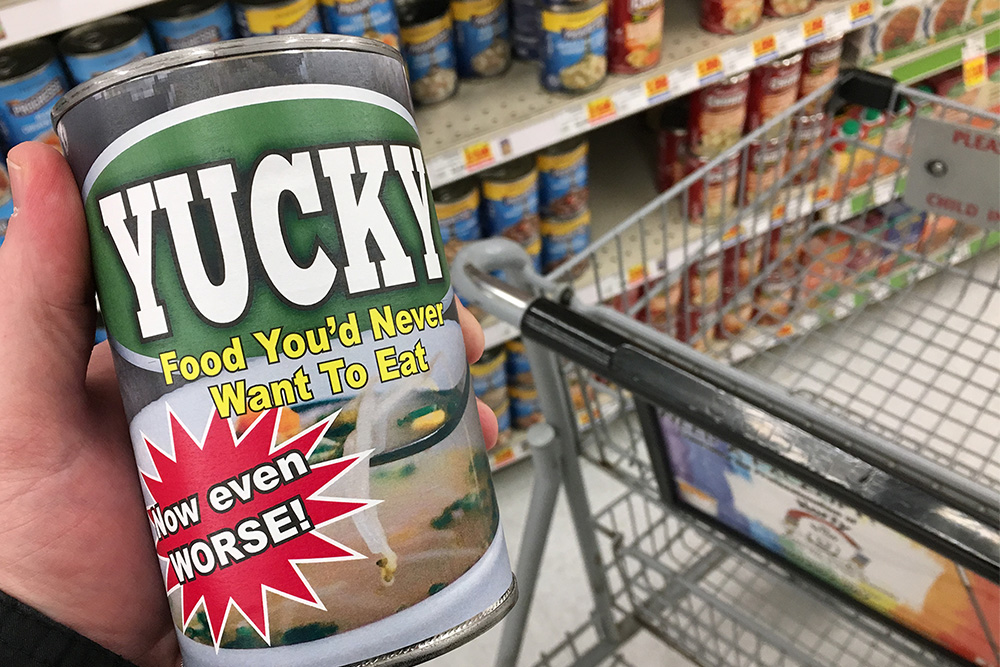 Storing the food you eat means you won’t be wasting precious shelf space on items you don’t want to ever eat. Don’t buy food for storage just because it’s on sale. If you don’t like canned beets, there is no reason to get them. Chances are they will just be pushed to the back of the shelf until they spoil. Then you have wasted your money. In an emergency situation where you are relying on your food storage, why torture yourself and add stress to an already stressful situation with food you and your family don’t like?
Storing the food you eat means you won’t be wasting precious shelf space on items you don’t want to ever eat. Don’t buy food for storage just because it’s on sale. If you don’t like canned beets, there is no reason to get them. Chances are they will just be pushed to the back of the shelf until they spoil. Then you have wasted your money. In an emergency situation where you are relying on your food storage, why torture yourself and add stress to an already stressful situation with food you and your family don’t like?
What foods and ingredients are in your pantry now? What do you and your family normally eat, day-to-day, that could be included in your food storage? Think of what's in your pantry right now. Get extras of those foods, and be sure to use and rotate them as needed. It doesn't have to have a twenty plus year shelf-life to be included in your food supplies. Most off-the-shelf foods have a shelf-life of less than a year.
How much do I need?
The bare minimum amount of food you need to have on hand without going to the store is one month’s full supply. This food is part of your normal rotation of food that you eat from everyday. It's what is in your pantry already. Therefore, when you get down to your minimum of one month, you are out of food and need to go to the store. If you are starting a long-term food storage plan, start off working toward a three month supply of everything you need. Don't spend all of your budget on a year's supply of one item, build your stores gradually, covering all of the areas of nutrition at the same time. Food storage for 6 months to a year or longer is recommended, but do not go into debt building your food storage supply or any other emergency preparedness supplies. Don't create a financial emergency while preparing for other emergencies. Have a goal to meet your preparedness goals, but stay within a budget. Store what you have room and and budget for.
Food Storage Basics
These items are the minimums that should be in a food storage supply. They cover nutrition and basic food preparation requirements. Most of these items can be part of a long-term food storage plan. This basic list will not work for everyone. It is intended to be a guide to help you get started in your food storage plans. You may need to change things on this list to meet your own needs and tastes. It is recommended that you consult your doctor or dietitian before putting a lot of resources into specific foods. Remember that nutrition comes from variety. Plan and gather a variety of grains. Plan and gather a variety of legumes. Plan and gather a variety of fruits and vegetables. Plan and gather a variety of proteins.
-
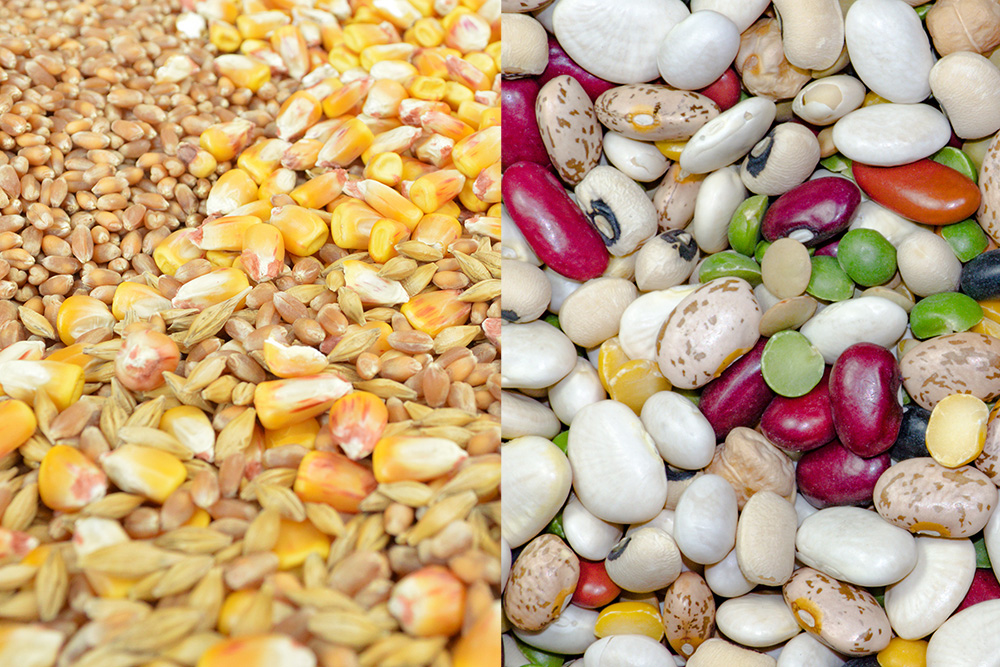
Grains and Legumes
Grains. Wheat is what most of us think about for traditional food storage and it is probably the foundation of many people's food storage supplies. It's gluten content is used in making bread, as is spelt. There are many other grains that can be used in food storage as well, such as rice, barley, millet, corn, oats, popcorn, and many others. Tapioca is not a grain, it's a root, but it can be nutritionally used as one and is very mild on sensitive digestive systems.
-
Legumes can be combined in a meal with grains to create a complete protein. This is essential in a diet that does not include meat or other animal products. Our bodies need proteins to build and repair muscles and other tissues. Legumes include things like beans, split peas, lentils, and peanuts.
-
Fats and oils are essential for energy, organ protection, and in breaking down some vitamins and nutrients so our bodies can use them. Some examples include cooking oils like canola, corn, vegetable, olive, etc. A solid fat like shortening is hydrogenated, but has longer shelf life than liquid fats and oils. These items should be stored and used in smaller amounts than other food storage items, but not eliminated. Used properly, they are an essential part of your nutrition and health.
-
Milk is used in many recipes and adds important proteins and vitamins to your food supply. While the milk that comes in the jugs only lasts a couple of weeks in your refrigerator, dry milk, regular or instant, when sealed in an air-tight can may last for three to five years. UHT (Ultra High Temperature) or "shelf" milk is cooked at a higher temperature than just what is required for the pasteurization process. This allows an unopen box of liquid UHT milk to last for a year or so in your pantry. Whey milk powder is made from milk and is a popular source of quality protein. It can be used in most recipes requiring milk, unless the recipe needs to set-up or solidify like pudding, custard, or cheese.
-
Sugars add flavor and work with leavenings in baked goods. These may include white sugar, brown sugar, molasses, honey, corn syrup, etc.
-
Salt is essential to health, is a necessary ingredient in recipes, and can be used as a food preservative. Iodized salt has potassium iodide added as a dietary supplement.
-
Leavenings are needed for breads, biscuits, cookies, pizza crust, and almost every baked good. Some examples include dry activated Yeast, baking soda, and baking powder.
-
Spices and seasonings make meals enjoyable, not just tolerable. You may not think of spices and seasonings as part of your emergency food storage, but why suffer through bland food in an already stressful situation? There are many different options. Try some new ones to see if you like them. Some basics include pepper, garlic, vanilla, cinnamon, pepper sauce, oregano, basil, cumin, etc., etc., etc.
Bouillons are an especially important part of your food storage supply. They make a bland meal of rice something nice, and can be used to enhance the flavor of meats and vegetables. Additionally, bouillon can make a very mild liquid soup with protein that can be consumed by a person with a weak digestive system when other foods may not be edible. -
Vitamin C and multivitamins can help fill in any of the other nutrition gaps that happen when changing or restricting your diet. Although they cannot supply all the nutrients you need by themselves, they can assist in keeping you and our family healthy.
The remaining items on this list are good to have in your home food storage supplies. They fill in addition nutrition gaps and allow you to expand the range of meals you can make with your food stores. Start with the basics listed above, and if you have budget and space, you can continue to add to your food storage with the items listed below. Again, you may need to change things on this list to meet your own needs and tastes. It is recommended that you consult your doctor or dietitian before putting a lot of resources into specific foods.
-
Eggs are used in many recipes and are an excellent source of protein. Though fresh eggs need to be refrigerated, dried whole egg powder can be used just like fresh eggs in recipes Add the dry powder with the dry ingredients, and the correct amount or water to reconstitute the egg with the wet ingredients. Follow the manufacture's label for fresh egg equivalent amounts. Dried egg mix has dry milk and oil added as filler and it costs less than whole egg powder. It may not work the same as whole egg powder in recipes. Both can be used to make scrambled eggs or omelets, though the texture is a bit different than from fresh eggs. Contrary to some opinions, covering fresh eggs in petroleum jelly is NOT a safe way of giving fresh eggs a shelf-life.
-
Fruits and vegetables are a good source of vitamins and fiber. These can be canned or dried to extend their shelf-life for many years. Add them to cereals and to soups to add flavor and healthy bulk to meals.
-
Pasta has along shelf-life and is easy to prepare and to share with others.
-
Meats are a good source of protein, but must be frozen, canned, or dried to have any kind of shelf-life. Freeze-dried chicken and beef can often be found in the preparedness isle of your local grocery store. Canned tuna is a healthy option that adds nutritional fatty acids to your food storage diet plan.
-
T.V.P. or Textured Vegetable Protein is a plant based meat substitute made from soybean. T.V.P. is less expensive than canned or dried meat and has a shelf-life lasting many years in unopened containers. It comes in many different flavors and can be mixed with actual meat or it can be used in many recipes in place of meat entirely.
- Pre-mixes and powders are a convenience that we have grown accustomed to. They make meal preparation quick and easy. There is no reason not to include them in your food storage, other than noting that many items need to used and rotated in about a year. Some ideas may include:
- Cheese powder, butter or margarine powder
- Cake, bread, pancake, muffin, cookie, etc. mixes
- Instant gelatin and pudding mixes
- Instant fruit drink, electrolyte drink, cocoa, coffee, etc. mixes
- Soup base, gravy mixes, potato flakes, marinades
- Other items as you see fit. Just keep in mind the need for rotation. Don't buy a year's supply of mustard all at once because it will expire all at once. Buy it incrementally, gradually building up, so you have your supply that is in constant rotation. Some ideas may include:
- Condiments
- Nuts, candies, seeds
- Snack items and comfort foods
Something is Always Better Than Nothing
Many of the issues on this page list the ideals of food storage and what the best for a long-term food storage supply. As in any emergency preparedness plan, there is ideal, and then there is the best we can do right now. Don't get discouraged if your space, budget, time, or other circumstances do not allow you to have ideal storage conditions, amounts, or even the suggested kinds of food. Don't go into debt. Do the best you can with what you have and what you can do. You may need to rotate items in your storage more often, but something is always better than nothing. Don't give-up. At the same time, don't be complacent with meager plans and supplies, because you and your family's preparations and survival is your responsibility. Be determined to work toward the goal of ideal as best as you can. Make it a priority.
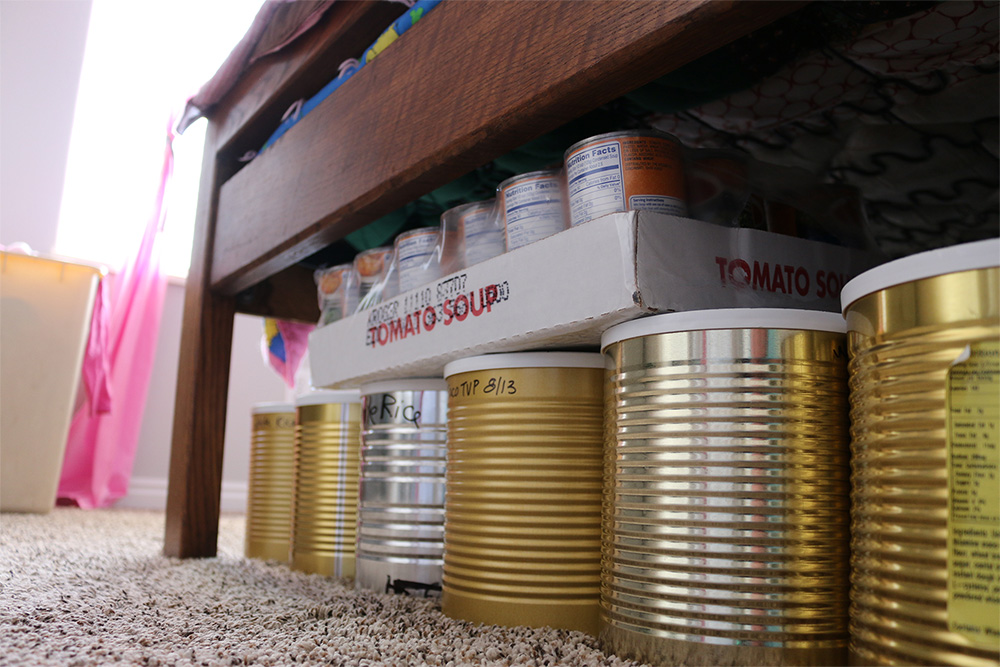
Be Creative With Storing Food Storage
If you don’t have a basement or you live in a small apartment with little or no storage area, you can "hide" storage under beds or other furniture. It may not be dark, but perhaps you can store it out of direct sunlight. It may not be cool, but maybe you can keep it in the lowest and coolest part of the house, or at least on the lowest shelves. It may not be ideal storage conditions, but it's better than nothing. Find empty areas in closets and other small spaces in your home and add shelves. If you already have a storage area, reexamine how you are storing things. Is there a way to reorganize and make more efficient use of the space? Put less space between shelves and look for other wasted space. You may have more room than you think. Even if your storage areas cannot exactly follow the guidelines for ideal, a less than ideal food storage area is better then no food storage area.
If you are limited on budget, don't buy a large supply all at once. Build up in increments. Get just a few additional items each time you go to the grocery store. Stock up when items are on sale, but don’t buy more than you and your family can use before expiration. Only buy what you will eat. Buying in bulk is usually cheaper per unit and less expensive over time. Focus on the basics of food storage first. Be sure you are covered on the staples of nutrition before you worry too much about desserts, condiments, and the short shelf-life comfort foods. Set an amount of your budget aside each month to put toward emergency food and supplies. Ask for food storage and other preparedness items for birthdays and other gift giving holidays and events. Cut back on the amount of ready made and fast food you purchase, then put those savings toward less expensive food you can put in storage and prepare yourself.
Be aware of the quality and source of the product you are buying. Just because it’s cheap doesn’t mean it’s a good buy. Check expiration dates and for damage to the packaging. If it's about to expire, don't plan on using it for long-term storage. If the can or other packaging is damaged, there's a good possibility that the food inside has also been damaged or contaminated. Don't buy it.
Organize Your Food Storage Area
- Think rotation when you are stocking your food storage supplies. First in, first out is the rule of thumb. Create a system where you are always using the oldest items first. Do whatever works for you, but make it easy to rotate.
- Keep like items together so it's easier to find what you are looking for. Soups on one shelf, tuna and canned meat on another, condiments all in one place, etc. Categorize and label your shelves. you can turn inexpensive business card magnets into labels on metal shelving so you can adjust what and where you store your items as necessary.
- Store efficiently and maximize the use of your space. Create room and eliminate wasted space with shelves. Minimize space between shelves. Use stackable containers to hold smaller items and save even more shelf space. Be sure to put a label on the containers so you don't have to rummage to find what you are looking for.
- Label cans and boxes with a use by date that is easy to see. The use by date is not necessarily a purchase date. Some items may have been sitting on the store shelf for a while before you bought it.
- Food storage maps or lists may be helpful if you have a number of shelves or if items are in different rooms. Draw a simple map or create a list that shows what is where so you don’t have to hunt for a particular item.
- Restocking lists make shopping and resupplying much easier. Keep an inventory list and mark items that need to be restocked as they are used. You grab a box of mac 'n cheese, mark it on the list as you are leaving the food storage area.
Storing Food Storage
 There are many variables that contribute to or detract from a food’s shelf life. Ideal storage conditions (cool, dark, and dry) allow your food stores to have the longest shelf-life possible. Different foods have different shelf-lives. Utah State University Extension's comprehensive Guide to Food Storage for Emergencies has information on how long you can store certain foods and how to maximize the shelf-lives of the foods you store.
There are many variables that contribute to or detract from a food’s shelf life. Ideal storage conditions (cool, dark, and dry) allow your food stores to have the longest shelf-life possible. Different foods have different shelf-lives. Utah State University Extension's comprehensive Guide to Food Storage for Emergencies has information on how long you can store certain foods and how to maximize the shelf-lives of the foods you store.
Expiration dates on store bought foods are extremely conservative and are just a suggestion for best quality and taste of the product, NOT nutritional value. Manufactures can’t know what conditions are in store warehouses, on the grocery store shelf, or even how you are going to store the product. Cans won’t explode and their contents won’t become toxic just because the stamped date is reached. It just means there is no guarantee that the food is at 100 percent nutritional value – but it still may be. Even then, 90% of the original nutrition value does not mean that the other 10% is toxic. Commercially canned foods have a few years of nutrition beyond the stamped "best by" date, but check for signs of spoilage. If there are signs of spoilage, discard the food without eating.
Whenever you are storing something for long term, remember that the ideal conditions are cool, dark, and dry at temperatures between 40° and 70° F. Do not get discouraged if you are unable to create ideal storage conditions for your food storage plan. Do the best you can with what you have now and make a goal to upgrade as time, budget, space, and circumstance allow. Something is always better than nothing. Utah State University Extension has more information on ideal food storage conditions. Here is a list of some of the things that can negatively affect your food storage and how you can mitigate their effects:
- Oxygen breaks down the nutrients in food, causing it to go rancid or even spoil. If there are insect eggs or larvae in your dried grains or other dried foods (which is more common than you'd like to think) oxygen allows them to live and grow while feasting on your food stores.
- To keep oxygen out of your dried foods, purchase high quality food storage in pre-sealed, air tight #10 cans (the coffee sized cans) or buckets that have had the oxygen removed. If you purchase bagged foods for your storage, transfer that food to clean, food grade buckets with air tight lids with gasket seals.
- Food grade foil lined plastic bags, commonly know as Mylar can be used to line food grade buckets for additional oxygen and moisture protection, or by themselves for smaller amounts of dry food. Either way, a heat sealer is needed to effectively seal the bags closed.
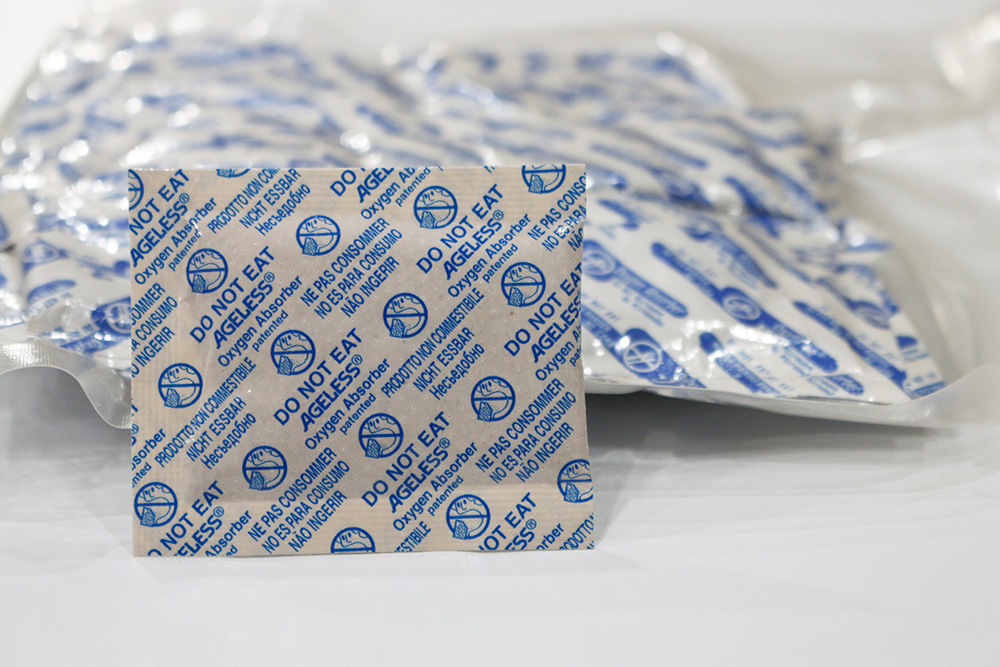
Oxygen Absorbers
- Oxygen absorbers absorb the oxygen around the food in the storage container by oxidizing the iron and salt contents in the absorber packet. One 300cc packet is sufficient for removing the oxygen from a one gallon container. Utah State University Extension has more information on oxygen absorbers and how to use them.
- Moisture buildup on and around the outside of your food storage containers can cause foods like sugar and salt to clump together. It rusts cans and can seep inside containers and bags, promoting deterioration and the growth of mold and bacteria. These will then produce toxins in your food that cannot be removed or even “cooked out”. If any bagged foods get wet or have an off smell form mold, throw it out. If any canned foods are bulging, leaking, smelling bad, squirts fluid when opened, was frozen (fractures seals), has a milky appearance to the liquid, or has rust or other corrosion on the inside of the can or on the seam – discard it. Any of these could be botulism. A good rule of thumb for potentially spoiled food is, "If in doubt, throw it out.”
- Only store dry foods that have 10% moisture content or less, otherwise there is a risk of botulism.
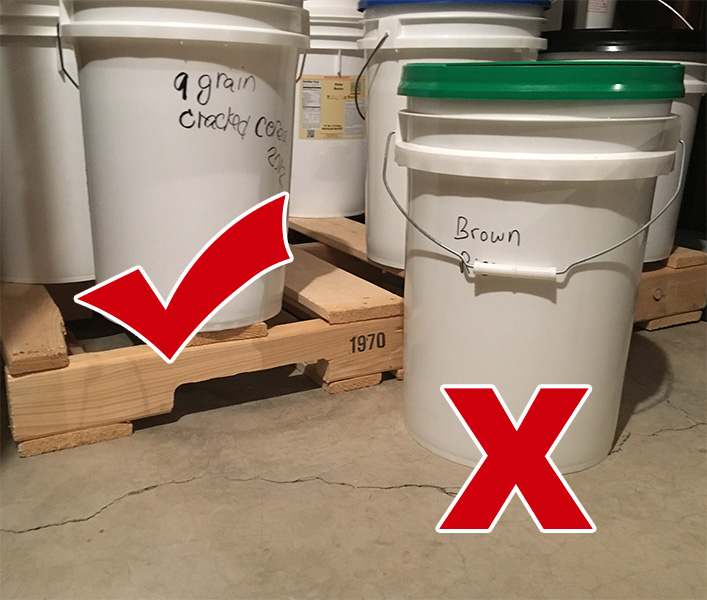
Keep It Off the Floor
- Keep containers off floors and walls to prevent condensation. Direct contact with cool items causes concrete to “sweat”. Use pallets or shelving to let air circulate around the storage containers and allow moisture to evaporate.
- Store whole kernels of grains. Each whole grain kernel is like it's own little storage container protecting the inner parts from spoiling. Whole grains are known to hold their nutritional value for decades or longer. Ground grains start to loose their nutritional value in less than a week.
- Only store dry foods that have 10% moisture content or less, otherwise there is a risk of botulism.
- Light from the sun, and even artificial light, degrades food’s nutritional value, especially vitamins A,D,E and K. Limit sunlight, or any light, as much as possible in food storage areas.
- Store in dark rooms. Basements are ideal storage locations, but any room that is chosen needs to have covered windows, possibly even with aluminum foil to block light and heat from entering.
- Store in solid colored containers. If you are using air-tight, food grade buckets, make sure they are solid colored to block as much light as possible, even if that light is only from a light fixture.
- Store in light blocking bags. An additional measure you can take is to store the food in foil lined plastic bags before putting them in plastic buckets, as mentioned before. Not only does it keep out oxygen and moisture, but light as well. Don’t store your dry food in garbage bags, they are often treated with pesticides.
- Warm temperatures cause a faster decay in food nutrients and cause food to spoil. For every 18° F increase in temperature above ideal (40° to 70° F), you lose half of your food’s shelf life.
- Limit extremes in temperatures in storage areas as much as possible. Cycles of freezing and thawing can loosen seals or even break storage containers.
- Store indoors if you have room. Avoid sheds and garages for storage unless they are well insulated.
- Keep it low. Remember that heat rises. Store items with shorter shelf lives, like dairy and oils, closer to the ground on a lower shelf where it is cooler. If you have a basement or a low level room, try to keep the majority of your storage there. Avoid attics and upper level rooms that tend to be warmer.
- Insulate the room if you can by insulating around windows and covering them. Cover heating vents. Inside doors can also have adhesive foam stripping around them to keep heat out and cool air in.
- It is a good idea to put a thermometer and humidity gauge in your storage room to monitor your storage conditions.
-
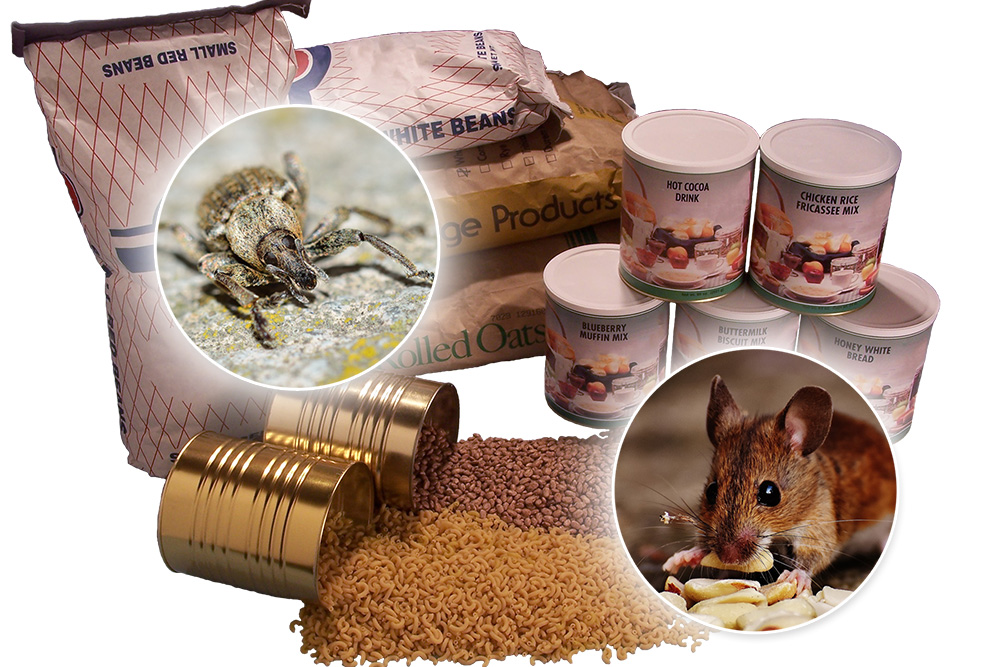
Insects and Rodents
Insects and rodents eat your food, lay eggs in your food, and deposit toxic waste in your food. Unlike roaches and rodents, weevils, which are commonly found in wheat and other dried grains, are not harmful if eaten. You'd probably rather eat your stored grain than the weevils. Utah State University Extension has more information on food storage pests. Utah State University Extension's comprehensive Guide to Food Storage for Emergencies (page 89) has further information on what does and does not work for insect treatments.
- Remove oxygen in your food and their containers following the instructions listed above. When the infesting pests can’t breath, they die.
- Use pest resistant containers. Don't encourage infestations by making your food easily accessible. Empty bags into buckets or purchase storage that is already in sturdy containers.
- Remove infested foods immediately to the outside. Put infested items in the outside trash and spray it with insecticide. Otherwise, if you try to "rescue" the infested food or treat it indoors, bugs may find their way out and into other food storage.
- Traps and poisons should be used with CAUTION. Be sure not to mix poison directly with food storage. It may be best to use a professional exterminator to eliminate pests before they enter your home, and to safely deter pests in your food storage area.
Disaster Supply Kit: Food
Click Here
